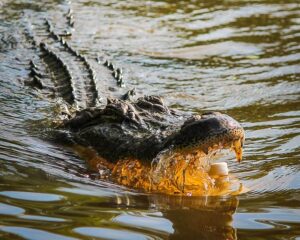 Greetings, readers. Today we continue our series, Caring for Mother Nature, by my friend, author and naturalist, Peggy Sias Lantz (click her name to go to her website).
Greetings, readers. Today we continue our series, Caring for Mother Nature, by my friend, author and naturalist, Peggy Sias Lantz (click her name to go to her website).
This time, she opened my eyes about alligators. Since I live in Florida, like Peggy does, I’m VERY aware of these creatures who populate many of the lakes around here. They make me nervous. I steer clear of any sight of them, unlike Peggy. In this article, you will see how she lives happily alongside these infamous reptiles.
Alligators
by Peggy Lantz
I learned to swim in Lake Lucy when I was three or four years old, and I was still swimming in it last summer and will be again as soon as it gets warm enough.
“You swim in the lake?!!”
“Yes.”
“Aren’t there alligators?”
“Yes.”
“Aren’t you afraid?!!”
Sigh. “No.”
Pause.
“Yes, there are alligators in the lake. When I walk down to the dock, if there is an alligator nearby, I hear this big splash, and if I watch for a minute, an alligator’s head will appear somewhere out in the middle of the lake.
“If nobody feeds the alligators,” I explain, “then the alligators are afraid of me.”
What do you know about alligators?
Item number one: They are probably present in almost any wet place in Florida and in Georgia and in South Carolina and west to Texas. Its biological name is Alligator mississippiensis, so the person who named it saw it first in Mississippi. This animal gets around!
Alligators mate from spring to early summer. Males attract females by bellowing in a deep voice, sending ripples across the lake. When my grandfather brought his family to Lake Lucy (which he named for his mother), a big bull alligator lived in the lake and bellowed regularly, waking my grandfather early in the morning. Grampa would take futile shots at it with a small .22 rifle. Bullets that small just bounced off the gator’s back. But one morning he shot high in the air at the gator in the middle of the lake – and it hit the gator in the eye, killing it! I still have a vertebra from it that my Dad and his brother found after the dead gator floated ashore and began to rot. (Story about this in my book, Lake Lucy Tales. Visit Lake Lucy Tales | Peggy (peggysiaslantz.com)
So, about ‘gators.
Mama ‘gator builds a nest near the edge of a lake or in a marshy area of cattails, grasses, and other vegetation, which heats up as it rots, just like your compost pile. She lays about 35 to 50 eggs inside the pile. If the pile is in a sunny area, all of the alligators will hatch as males. If in a shadier place, they’ll all be females. The temperature matters.
Mama will hang around during the two-month incubation period, and when she hears the pipping noises from the nest, she will uncover it and carry the hatching babies in her mouth to the water’s edge. And mama and babies will stay together for a year or two. They’ll be six to eight inches long at birth and will be a foot and a half in a year.
They can live 30 to 50 years in the wild.
Newly hatched alligators are vulnerable to predators. Raccoons, Great Blue Herons, otters, and bigger alligators eat them, and – as you’ve probably read – Burmese pythons try to eat bigger ones. And, of course, humans hunt both babies and adults.
And as soon as the spring sunshine warms the lake, I’m going to go swim with my alligators.
—END—
Thanks for reading!
Your writer on the wing,
Charlene







Linda Goddard
Oh Charlene,
What a delightful outlook Peggy has on alligators! I just love her story!
But I’m too much a coward to even think about swimming with the gators. I know a gal would have to be pretty unlucky to meet up with one, but I’ll pass on lake swimming 😉
Charlene Edge
She sure has gumption, right?